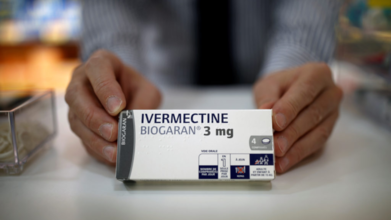- Health Conditions A-Z
- Health & Wellness
- Nutrition
- Fitness
- Health News
- Ayurveda
- Videos
- Medicine A-Z
- Parenting
People In Texas Could Soon Buy Ivermectin Without Any Prescription: What You Need to Know

Credits: Reuters
The Texas House of Representatives has passed House Bill 25, permitting the over-the-counter sale of ivermectin, a medication that has been used for decades to treat parasitic illnesses. The bill passed Wednesday after almost three hours of discussion, on an 87-47 vote and one member who was present but not voting. If the bill passes the Senate, Texans would be able to buy ivermectin from pharmacists directly, as with other drugs such as Sudafed.
Ivermectin, which was first discovered in the 1970s by Japanese microbiologist Satoshi Ōmura, has been a reliable cure for parasitic diseases like river blindness, scabies, lice, and strongyloidiasis. Its impact on global health earned Ōmura and collaborator William Campbell the 2015 Nobel Prize in Physiology or Medicine. The medication targets parasites by paralyzing and destroying them and disrupting their nerve and muscle functions.
Despite its long-standing medical credibility, ivermectin became a contentious topic during the COVID-19 pandemic. Early laboratory studies suggested antiviral activity, prompting some to tout it as a COVID-19 treatment. Subsequent research, however, failed to show meaningful benefits for patients, and the U.S. Food and Drug Administration (FDA) has repeatedly emphasized that ivermectin is not authorized or approved to treat COVID-19. The FDA warns that abuse, especially with the veterinary form, can result in serious side effects such as seizures and coma.
Rep. Joanne Shofner, a Nacogdoches Republican, wrote the bill, which has been identified as a priority for Governor Greg Abbott and House Speaker Dustin Burrows during the Legislature's second special session. Texas would join Arkansas, Idaho, Louisiana, and Tennessee as the fifth state to allow the sale of ivermectin without a prescription. Supporters point to "medical freedom" as a driving factor, saying patients deserve the ability to use treatments they think can help them, especially when vaccines or conventional therapy are rejected or considered inadequate.
The passage of the bill is part of a larger movement of alternative medicine activists, fueled by social media sites that have promoted ivermectin for a host of off-label applications, from COVID-19 to cancer care.
Why Is Ivermectin So Popular?
Though the FDA-approved applications of ivermectin still only include parasitic diseases, it persists in showing up in alternative medicine forums. It turned into an icon of skepticism surrounding traditional medicine in the time of the pandemic, spurring demand long after vaccines had been found. In the present day, ivermectin is being researched for use in cancer, though evidence is currently narrow and inconclusive.
During the 2025 American Society of Clinical Oncology (ASCO) Annual Meeting, preliminary trials testing ivermectin combined with immunotherapy in metastatic triple-negative breast cancer were inconclusive: six of eight patients had disease progression, one showed partial response, and one had stable disease. Oncologists warn that promising laboratory results do not yet constitute clinican evidence for ivermectin in fighting cancer.
What Are The Safety and Regulatory Concerns of Ivermectin Drug?
The FDA emphasizes that ivermectin is safe when taken as prescribed for parasitic diseases, but inappropriately or in error, it can be hazardous. Veterinary products, usually in greatly higher concentrations, are quite hazardous to humans. Opponents caution that the sale of ivermectin over the counter may lead to self-medication, with resulting adverse events.
Further, public health practitioners observe that although OTC access would be attractive to individuals who desire control of medical choices, it would complicate pharmacist counseling and regulatory control. Patients would not necessarily know proper dosing, interactions with other drugs, or the hazard of off-label use.
The Texas debate brings attention to persistent tensions between patient autonomy and medical authority. Supporters of OTC access posit that adults must be capable of making intelligent decisions, pointing to past safety in parasitic disease treatment. Opponents suggest wider availability would worsen misinformation about COVID-19 and cancer claims.
Social media has raised the level of interest in ivermectin, frequently citing cherry-picked studies or anecdotal experience as proof of efficacy. This pattern reflects a larger challenge for public health: the tension between patient autonomy and evidence-based recommendations.
House Bill 25 now heads to the Texas Senate, where it will be determined. If passed, Texans could soon have simpler access to a drug with a complicated past adulated for its Nobel Prize-winning use as an anti-parasitic but contested for its unproven uses in viral infections and cancer.
Experts note that although ivermectin does have valid medical applications, it is not a panacea. Those looking to use it for off-label purposes should see qualified healthcare professionals in an effort to reduce risk.
Texas' possible shift towards over-the-counter sales of ivermectin points to a wider cultural and medical discussion: the interplay of individual choice, scientific evidence, and public safety. As ivermectin is an important agent against parasitic disease, its greater availability sparks concerns about prudent use, public health education, and the place of evidence in shaping medical practice.
This battle is hardly over, but Texans and Americans generally are paying close attention as politicians work out the balance between independence, control, and science.
National Obesity Registry Launched To Address India’s Rising Obesity Crisis, Says Dr Jitendra Singh

Credits: Canva
Union Minister of State (Independent Charge) for Science and Technology and Earth Sciences, along with responsibilities in the PMO, Personnel, Public Grievances, Pensions, Atomic Energy, and Space, Dr Jitendra Singh on Tuesday called for careful and evidence-led use of anti-obesity and weight-reduction medicines. He stressed that these drugs should be prescribed thoughtfully and not treated as routine or easy solutions.
Addressing the inaugural session of the Asia Oceania Conference on Obesity (AOCO), the minister said obesity is a complex, long-term condition that tends to recur and cannot be managed through isolated medical treatment alone. Instead, he said, it needs a wider response involving society at large.
At the same event, Dr Singh also launched the National Obesity Registry, describing it as an important step towards strengthening India’s obesity research framework. The initiative aims to support structured data collection, generate reliable evidence, and guide long-term policymaking in the area.
What Is National Obesity Registry?
During the conference, Dr Jitendra Singh formally unveiled the AIAARO Obesity Registry, calling it a major move to strengthen India’s research ecosystem. The registry will focus on systematic data collection, long-term follow-up, and evidence-based policymaking. It is expected to help improve clinical understanding of obesity and support the development of national strategies for its management.
India’s National Obesity Registry (NOR), launched in December 2025, is designed to create a strong and reliable data base on obesity trends across the country. This data will support public health policies, research efforts, and targeted interventions to address the growing obesity burden. The initiative is particularly significant for India, given its unique challenges related to metabolic obesity and its strong links with non-communicable diseases.
While launching the registry, Dr Singh also highlighted the strong focus placed by Prime Minister Narendra Modi on tackling lifestyle-related illnesses. He noted that the Prime Minister has repeatedly spoken about obesity on national platforms, reflecting a clear shift towards preventive healthcare. This approach, he said, is supported by initiatives such as FIT India, Khelo India, and programmes that encourage small but lasting behavioural changes.
Obesity Cannot Be Treated with Shortcuts: Dr Jitendra Singh
The minister warned against the increasing commercialisation of obesity treatment and the spread of misinformation in this space. Referring to a PIB release, he said unscientific claims and so-called quick solutions often mislead people and divert attention from treatments backed by medical evidence.
India has seen a growing use of injectable obesity treatments such as Wegovy and Poviztra, both based on semaglutide, and Yurpeak, which uses tirzepatide. These once-weekly injections work by mimicking gut hormones that help regulate appetite and are marketed by companies like Novo Nordisk and Eli Lilly. However, doctors caution that these drugs are not miracle solutions and must be combined with proper diet and physical activity. There are also concerns about their overuse at a time when obesity rates continue to rise.
India And Obesity
According to the World Health Organisation, obesity was linked to 3.7 million deaths globally in 2024. If strong action is not taken, the number of people living with obesity is expected to double by 2030. Recently, the WHO released its first-ever guideline on the use of Glucagon-Like Peptide-1, or GLP-1, therapies for managing obesity as a chronic and relapsing condition.
“Obesity is a major global health challenge that WHO is committed to addressing by supporting countries and people worldwide to control it effectively and equitably. Our new guidance recognises that obesity is a chronic disease that can be treated with comprehensive and lifelong care,” said WHO Director-General Dr Tedros Adhanom Ghebreyesus.
New Nipah Virus Vaccine Passes Phase 1 Safety Test, Shows Strong Antibody Response: Lancet Study

Credits: Canva
A Phase 1 randomised clinical trial of a new Nipah virus vaccine, led by researchers in the US, is offering fresh hope for preventing this deadly infection. The study found that all three doses and vaccination schedules of the candidate vaccine, called HeV-sG-V, were safe and successfully triggered an immune response. These findings were published in the medical journal The Lancet.
The World Health Organization has identified Nipah virus as a high-priority pathogen because it can be fatal in up to 82 percent of cases and currently has no approved treatment or preventive vaccine. The virus is mostly seen in parts of Southeast Asia.
What Is Nipah Virus?
Nipah virus, or NiV, is mainly spread by fruit bats but can also pass through pigs and other animals. It can lead to serious illness and death, and there is currently no medicine or vaccine available to treat or prevent it. According to the Cleveland Clinic, the virus is most commonly reported in Asia, especially in Bangladesh and India.
The virus can spread when:
- People or animals come into contact with bodily fluids such as blood, urine, stool, or saliva from an infected animal.
- People consume food that has been contaminated by an infected animal.
- People are in close contact with someone who has Nipah virus, often while caring for them.
The most effective way to reduce the risk of Nipah virus infection is to avoid contact with sick animals, particularly bats and pigs, in regions where the virus is known to circulate. This also means avoiding foods that could be contaminated, such as raw date palm sap or partially eaten fruit. Since Nipah can spread from person to person through bodily fluids, extra caution is advised when interacting with infected individuals.
Lancet Study Reveals New Nipah Vaccine Is Safe
A Phase 1 randomised clinical trial of a new Nipah virus vaccine has raised hopes that prevention may soon be possible. The trial showed that the vaccine was safe and produced an immune response, according to findings published on December 13 in The Lancet.
“The induction of antibodies within one month of vaccination, along with the sustained response seen with two doses, suggests this vaccine candidate could be useful both during outbreaks and for preventive purposes,” said researchers from Cincinnati Children’s Hospital Medical Center, which led the study, as per NDTV,
Scientists from the Indian Council of Medical Research–National Institute of Virology in Uttar Pradesh described the results as a “milestone” in Nipah vaccine development in an accompanying editorial published in The Lancet. The Phase 1 trial involved 192 healthy volunteers between the ages of 18 and 49.
The study found that a single dose did not produce a strong enough immune response. However, two doses were effective, with the strongest antibody responses seen in participants who received two 100-microgram doses of HeV-sG-V given 28 days apart.
The most common side effect reported was mild to moderate pain at the injection site. No serious side effects, hospital admissions, or deaths were reported during the trial. In their editorial, ICMR-NIV experts noted that the vaccine should next be tested in a larger Phase 2 trial to better understand its safety profile and determine how much protection it can actually provide.
Flu A Is Ramping Up, Experts Warn That It Could Cause Widespread Disease

Credits: iStock
Flu A, or the new version of the flu virus called H3N2 is spreading quickly, the worst part is that fewer people are getting the flu shots. Doctors and scientists say that this year's influenza season could be tougher than the usual. Dr. Amanda Kravitz, a pediatrician at Weill Cornell Medicine in New York in an interview to CBS Mornings, said, "This flu season is no joke. We are seeing more cases than we would expect for this time of year. We are seeing influenza A, and within influenza A we are seeing a subtype or variant called H3N2."
Scientist Jesse Bloom, at the Fred Hutchinson Cancer Center who studies viral evolution said that "it is pretty likely to be an H3N2-dominated flu season. I don't see any reason to think that this is an unprecedentedly bad one, but current indicators are that it may be substantially more severe than the typical winter flu season," as reported by CBS News.
Also Read: Adenovirus: Why This Mysterious Virus May Spread Faster Than Covid-19 And Flu
Not just the UK, but as per the journal of the British Medical Association, even the United Kingdom is suffering from an early and severe fly season, all thanks to the influenza A H3N2 called subclade K. Neil Maniar, director of the master of public health program at Northeastern University said, "The United Kingdom got hit pretty hard by this," as well as Europe and Australia. "I think that's a pretty good harbinger of what we are likely to see here. This is going to be a very difficult flu season."
Experts are pointing out that while the vaccine may not be a good match for the updated flu virus circulating, it is still the best line of defense. Flu vaccines have an efficacy rate of 40% to 60%, however, as per as early report by Eurosurveillance, the efficacy of the current vaccine rate was between 32% to 39% in adults, and 72% to 75% in children. However, it is still important to get the vaccine to avoid any severe illness from the flu virus, point out experts.
"If you haven’t done so, get (the vaccine)," Maniar pointed out. “Definitely get it as we go into the holidays, as we go into new year’s and the new school year." It takes about two weeks to build up a solid immune response, however, within several days of getting the vaccine, people start to develop some immunity.
Read: Flu Cases In US Reach 5 Million Mark, Reveals CDC Data
The Virus Is Changing
Dr Helen Chu, a flu expert at the University of Washington told the CBS News that based on the UK and Japan data, there will be more cases of hospitalization by this flu. The flu activity is "starting everywhere right now" and would be overlapping with RSV, before the winter COVID-19 wave.
Trevor Bedford, who also studies viral evolution at the Fred Hutchinson Cancer Center, said H3N2 tends to evolve faster than other influenza strains. "I expect more H3 incidence than the typical year and poorer vaccine effectiveness," he said.
"Total season effectiveness is probably going to actually be much, much lower," Chu warned, because immunity fades over time.
However, despite the mismatch in the vaccine, experts stress the fact that the flu vaccine is still helping preventing severe illness, especially in children. They also help in preventing severe diseases, hospitalization and deaths.
© 2024 Bennett, Coleman & Company Limited

